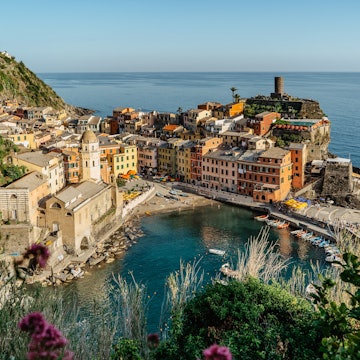

Greece's natural wonders will definitely spark inspiration for your next trip (whenever that is) © Dziewul / Shutterstock
Days melt from one to the next under wide-open Greek skies on sea speckled with islands fringed with the white-sand, pine-tree shade beaches of your dreams. Hike up volcanoes, watch for dolphins and sea turtles, and cycle through lush forests. Meander through olive groves and petrified forests to thoroughly enjoy all of Greece's natural wonders.
Editor's note: Please check the latest travel restrictions before planning any trip and always follow government advice.
Mt Olympus
The cloud-covered lair of the Ancient Greek pantheon, awe-inspiring Mt Olympus is simply spectacular. It fires visitors' imaginations today, just as it did for the ancients who venerated it. Greece’s highest mountain, Olympus hosts more than 1700 plant species, some rare and endemic, as well as wolves, jackals, deer and more than 100 bird species. Its slopes are thickly forested and its peaks often shrouded in fog.
Preveli Beach
With its heart-shaped boulder lapped by the bluest waves just offshore, Crete’s Preveli Beach is one of Greece's most iconic. Bisected by a freshwater river and flanked by cliffs concealing sea caves, Preveli is a thick ribbon of soft sand on the Libyan Sea, with clear pools of water along its palm-lined riverbank that are perfect for cool dips.
Paradeisos Waterfalls
About 500m (1640ft) past Kafeneio Ta Therma, a lush wooded path (100m/328ft) leads to a series of rock pools and waterfalls, the most impressive being 30m (98ft) in height. This is gorgeous, Lord of the Rings–like terrain, where gnarled 600-year-old plane trees covered in moss loom out of fog over a forest floor of giant ferns and brackish boulders. Get ready for an ice-cold dip on a hot summer's day.
Cave of the Lakes
The remarkable Cave of the Lakes lies 16.5km (10.3mi) south of Kalavryta near the village of Kastria. A 500m (1640ft) boardwalk snakes its way through the cave, through the vast entrance chamber (home to five species of bats) past spectacular cauliflower-like rock formations, and over the deep, crystal-clear subterranean pools – the 13 stone basins formed by mineral deposits over the millennia. The most impressive formations are in the final chamber, where delicate, ribboning curtains cascade down the wall.
Samaria Gorge
The dramatic gorge of Samaria is the most-trodden canyon in Crete – and with good reason. Starting near Omalos and running down through an ancient riverbed to the Libyan Sea, it's home to soaring birds of prey and a dazzling array of wildflowers in spring. It’s a full day's walk (about six hours down) but the jaw-dropping views make it worth every step. To get more solitude, try lesser-known Imbros Gorge, which runs roughly parallel to Samaria and is around half the length.
Melidoni Cave
About 2km (1.2mi) outside the village of Melidoni is this stunning cathedral-like cave, an evocative underworld of stalactites and stalagmites. A place of worship since Neolithic times, it also carries heavy historical significance as the site of a massacre in 1824 during the Turkish occupation. Here 370 villagers and 30 soldiers sought refuge from the Ottoman army; after a three-month siege, the Turks lit a fire and asphyxiated the people inside, including 340 women and children.
Wear decent walking shoes, as the cave is poorly lit and the ground uneven and slippery in places. You’ll need to descend 70 steps into the cave. Also, bring a sweater: at 24m (79ft) below ground, the temperature never gets above 18°C (64°F).
Skopelos
Pine forests, olive groves, rippling vineyards and orchards of plums and almonds (many of which find their way into local cuisine) carpet the handsome island of Skopelos, which is notably wilder, artier and more laid-back than neighboring Skiathos. Though famed for its starring role in the 2008 film Mamma Mia!, Skopelos has managed to hang on to its low-key charm. The island's sheltered southeast coast harbors a string of beautiful sand-and-pebble beaches, while the northwest coast's high jagged cliffs are exposed to the elements.
Meteora
Magnificent Meteora will leave you speechless. Soaring pillars of rock jut heavenward, a handful complete with monasteries perched on their summits. Built as early as the 14th century, these were home to hermit monks fleeing persecution. The rope ladders that once enabled the monks to reach the top have long been replaced by steps carved into the rock, and six of the 24 monasteries remain open to resident monks and visitors alike. Today this spectacular stone forest beckons pilgrims and rock climbers from around the world.
Caldera
A visit to the caldera is like stepping into a science fiction movie, cows grazing amid strange colored rocks in what resembles a lunar landscape. The largest crater is Stefanos, where you can examine the multicolored 100°C (212°F) fumaroles, listen to their hissing and smell the sulfurous vapors.
The surface is soft and hot, making sturdy footwear essential. A track leads to the wilder craters of Polyvotis and Alexandros. Take great care here as it's unsupervised, not fenced and fumaroles are around the edge. If you're staying on the island, get here by 11am to avoid the busloads of day troopers that arrive from Kos.

Koukounaries Beach
Framed by electric-green pine trees, two forested headlands and a small salt-water wetland, Koukounaries' silky 1200m-long (3937ft) sweep of bleach-blonde sand is the island's (and one of the country's) most sparklingly beautiful, with beach bars, sunbeds and water sports creating a buzzy vibe. The beach gets completely packed in summer – but that's half the fun. The whole area is a protected nature reserve.
You might also like:
10 best beaches in Greece
Greece's top hiking destinations
Virtual Vacation: Greece
















